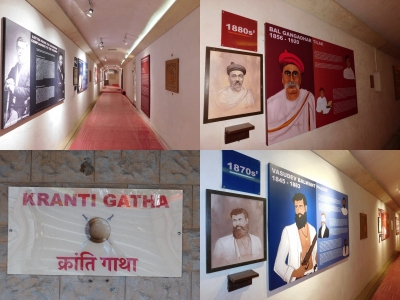PM To Unveil India’s 1st Underground Museum Of Revolutionaries

Mumbai, June 13: Prime Minister Narendra Modi will inaugurate the country’s first-ever underground ‘Gallery of Revolutionaries’, a museum dedicated to the luminaries of the Indian Independence Movement, created at the Maharashtra Raj Bhavan, on June 14.
The PM will throw open the gallery themed as ‘Revolution Saga’ that has come up in the subterranean network of 13 pre-World War-I (First WW) British era bunkers, discovered in the sprawling Raj Bhavan campus in August 2016 during the tenure of the then Governor C. Vidyasagar Rao.
Later, current Governor Bhagat Singh Koshyari oversaw the setting up of the Gallery of Revolutionaries under guidance of Dr. Vikram Sampat (historian) and help from South Central Cultural Centre, Nagpur.
In the first phase, the museum features rebels like Vasudev Balwant Phadke, Damodar Hari Chapekar and Vishnu Hari Chapekar (Chapekar Brothers), Lokmanya Bal Gangadhar Tilak, the Savarkar Brothers – Vinayak Damodar Savarkar (Veer Savarkar) and Ganesh Damodar Savarkar (Babarao Savarkar), Anant Laxman Kanhere, Vishnu Ganesh Pingale, Vasudev Balwant Gogate, Krantiguru Lahuji Raghoji Salve, Bhikaiji Rustom Cama (Madam Cama), Shivran H. Rajguru, the country’s first armed fighter organisation ‘Abhinav Bharat’, ‘Patri Sarkar’, etc.
There will be hundreds of others, known and unknown, who will figure at the museum in its later phases, depicting the entire ‘Revolution Saga’ of 90 years, from the First War of Independence in 1857 to India’s Freedom in 1947, said Raj Bhavan officials.
Besides the Governor, Chief Minister Uddhav Thackeray, Deputy Chief Minister Ajit Pawar, Chief Justice of Bombay High Court Dipankar Datta, other ministers and top officials shall be present for the ceremony, part of the Azadi Ka Amrit Mahotsav celebrations.
The gallery includes information on the freedom heroes, their role in the Independence movement, sculptures, rare photographs, murals and even details on tribal revolutionaries drawn by school-kids.
The stuff on display has been sourced from the State Archives Department, Asiatic Society, Kesari Archives, Savarkar Museum, etc, and also includes a scene from the historic Coronation of Chhatrapati Shivaji Maharaj in the hall of the underground hall of the bunkers.
The PM will also inaugurate the newly constructed ‘Jalbhushan’, which houses the Governor’s office and residence, and pray at the historic Shrigundi Temple at Raj Bhavan.
Soon after the bunker’s discovery, the government ordered the conservation of the underground structure which was neglected for over a century with the constant water leakages rendering the ‘Jalbhushan’ building standing above it architecturally unsafe.
“The bunker has been conserved without compromising the security of the historic building which is the heritage of Raj Bhavan and the Governor’s residence and office, ‘Jalbhushan’ stands on the upper side of it,” said an official.
A structural audit of the underground bunker – comprising 13 rooms of various sizes plus a grand 20-feet-tall entrance, a fort-like structure with a long ramp to take guns inside – was carried out and then it was strengthened by expert teams.
The cells in the bunker were known as ‘Shell Store’, ‘Gun Shell’, ‘Cartridge Store’, ‘Shell Lift’, ‘Central Artillery Room’, ‘Workshop’, etc, it had a proper drainage system, clean air and natural light plus lamp recesses kept in different places to illuminate it at night.
The conservationists took full care to preserve all the original features while restoring the bunker as well as now hosting the gallery of revolutionaries in that place.
Incidentally, on August 18, 2019, President Ram Nath Kovind had inaugurated a virtual reality museum in the bunker, but many other rooms were empty and now have been utilised for the Revolution Saga gallery.
The new ‘Jalbhushan’ has a history over two centuries, tracing to the days when the then Governor of Mumbai, Mountstuart Elphinstone (tenure Nov. 1819-Nov 1827) constructed a small bungalow called ‘Pretty Cottage’ at Malabar Hill between 1820-1825, where the present-day imposing ‘Jalbhushan’ now stands.
Since the relocation of the Government House at Malabar Hill in 1885, it served as the residence of the British Governor and then the Governor of Mumbai Province and post-Independence, the Governor of Maharashtra after the formation of the Marathi state.






